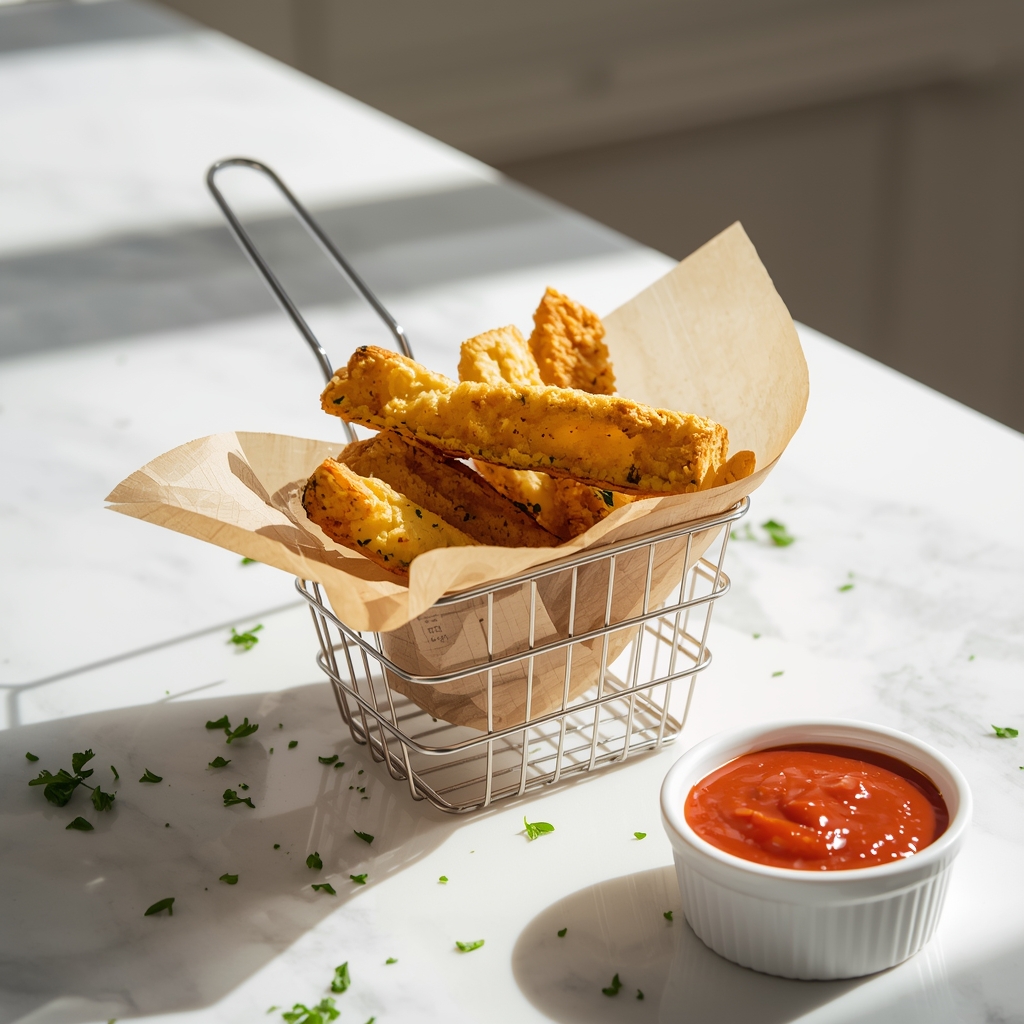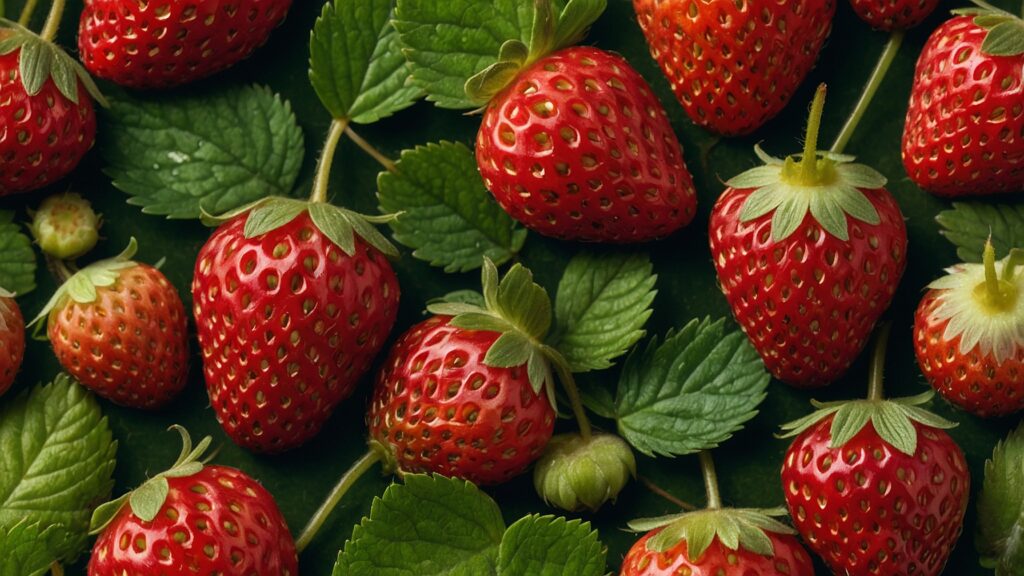
I never thought I’d be the person preaching about wild strawberries, but here I am, completely transformed. Let me take you on a journey that started with a simple question – Are Wild Strawberries Edible? – and ended with a life-changing discovery about these tiny, flavorful gems. It’s a story of curiosity, challenge, and ultimately, a whole new way of looking at the world around me.
My Wild Strawberry Awakening
Picture this: It’s a warm spring morning, the kind where the air feels alive with possibility. I’m out for a hike in the nearby woods, my boots crunching on the leaf-strewn path. The sunlight filters through the canopy, creating a dappled pattern on the forest floor. As I’m walking along the trail, I spot a patch of small, red berries nestled among some green leaves.
My first thought? “Those look like strawberries, but they’re so tiny! Are wild strawberries edible?”
That simple question was like a pebble dropped into a still pond. The ripples it created would spread far beyond that moment, transforming not just my diet, but my entire approach to food and nature.
Reflection moment: When was the last time a simple question led you down an unexpected path of discovery? What might you be overlooking in your everyday environment?
The Great Strawberry Hunt: From Curiosity to Obsession
My curiosity piqued, I found myself spending every spare moment researching wild strawberries. Field guides became my bedtime reading. I scoured online forums and botanical websites. I even signed up for a local foraging workshop, much to the amusement of my friends who couldn’t understand my sudden berry obsession.
“You’re spending your weekends doing what?” my best friend laughed when I canceled our usual brunch plans. “Searching for tiny strawberries in the woods?”
But I was undeterred. There was something about these little berries that called to me. Maybe it was the thrill of discovery, or perhaps a deeper longing to connect with the natural world. Whatever it was, I was hooked.
Identifying Wild Strawberries: Nature’s Hidden Treasures
Before we dive deeper into my culinary adventures, let’s talk about how to identify these little beauties. The wild strawberry (Fragaria virginiana) is a member of the rose family (Rosaceae) and is native to North America.
Here’s what to look for:
- Leaves: Trifoliate (groups of three), with toothed edges and slightly hairy undersides. They’re a deep green on top, lighter underneath.
- Flowers: White with five petals and a golden yellow center, about 1-2 cm wide. They’re like tiny stars scattered among the leaves.
- Fruit: Small red berries, about 1-2 cm in diameter, with seeds on the outside. They’re like miniature versions of the strawberries you’d find in a grocery store, but with an intensity of color that’s almost unreal.
- Plant height: Usually between 5-15 cm tall. They’re low to the ground, often hiding under taller plants.
- Habitat: Moist areas, woodland edges, meadows, and even in partially shaded spots. They’re adaptable little plants!
One important note: Be sure you’re not confusing wild strawberries with mock strawberries (Potentilla indica). Mock strawberries have yellow flowers and fruit that, while edible, is pretty tasteless. It’s like nature’s own bait-and-switch!
Safety first: Never eat any wild plant unless you’re 100% sure of its identification. When in doubt, consult an expert or leave it be. It’s better to miss out on a tasty treat than risk your health!
My First Wild Strawberry Taste Test: A Flavor Explosion
After weeks of research and careful identification, I finally felt confident enough to taste a wild strawberry. I’ll never forget that moment. The sun was setting, painting the sky in hues of pink and gold. A gentle breeze carried the scent of pine and earth. I plucked a single, perfectly ripe berry and popped it into my mouth.
The flavor explosion was incredible! It was like the essence of a strawberry, concentrated into a tiny package. Sweet, slightly tart, and incredibly aromatic. Imagine the juiciest, most flavorful strawberry you’ve ever had, then multiply that sensation tenfold. That’s a wild strawberry.
I stood there, in the middle of the woods, my taste buds singing with joy. In that moment, I understood why our ancestors valued these little fruits so much. They’re not just food; they’re an experience.
But my journey didn’t stop there. I wanted to know more about these little berries and how I could incorporate them into my diet. Little did I know, this was just the beginning of a culinary adventure that would transform my relationship with food.
Recipe #1: Wild Strawberry and Mint Infused Water
My first experiment was simple, born out of a desire to capture the essence of that forest moment in a refreshing drink:
Ingredients:
- 1 cup wild strawberries
- A handful of fresh mint leaves
- 2 liters of water
Instructions:
- Gently wash the strawberries and mint, handling them like the precious gems they are.
- Place them in a large glass jar or pitcher.
- Fill with water and let infuse in the refrigerator for at least 2 hours, or overnight for a stronger flavor.
The result was a refreshing, lightly flavored water that was perfect for hot summer days. The pale pink hue was beautiful, like a summer sunset captured in a glass. It was a far cry from the artificially flavored waters I used to buy, and I felt good knowing I was hydrating with all-natural ingredients.
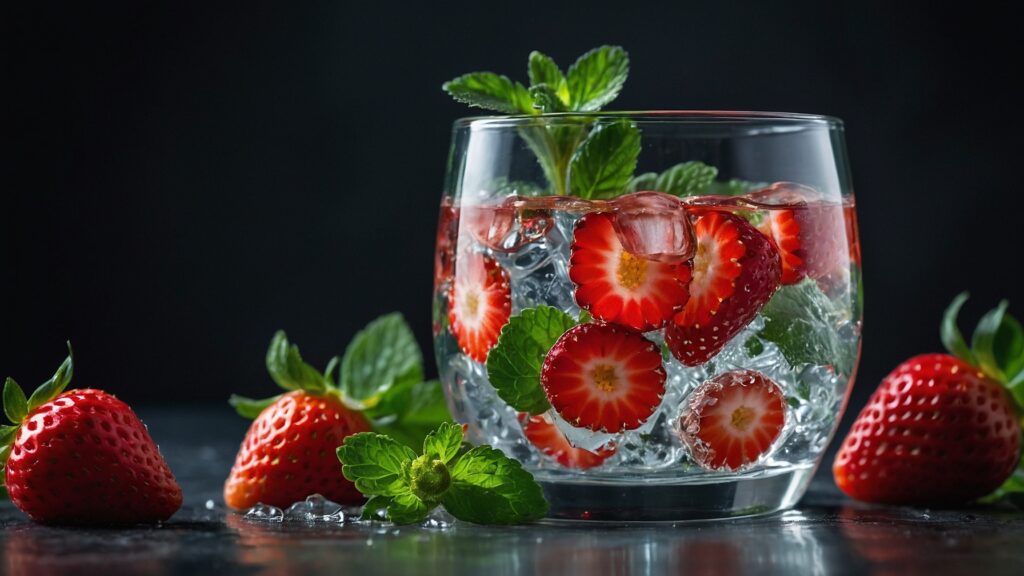
Small win celebration: I did a little happy dance in my kitchen when I took my first sip. It felt like I had bottled a piece of the forest!
The Nutritional Powerhouse: Wild Strawberries Unveiled
As I dug deeper into my research, I was amazed to learn about the nutritional benefits of wild strawberries. These tiny berries pack a powerful punch:
- Rich in Vitamin C: Even more so than cultivated varieties! A handful of wild strawberries can provide a significant portion of your daily Vitamin C needs.
- High in antioxidants: These little berries are packed with compounds that help combat free radicals in the body, potentially reducing the risk of chronic diseases.
- Good source of manganese: Important for bone health and wound healing. Who knew these delicate berries could be so tough?
- Contains folate: Essential for cell function and tissue growth, making wild strawberries a great choice for overall health.
Learning about these benefits made me even more excited to incorporate wild strawberries into my diet. It was like I had discovered a secret superfood growing right in my backyard!
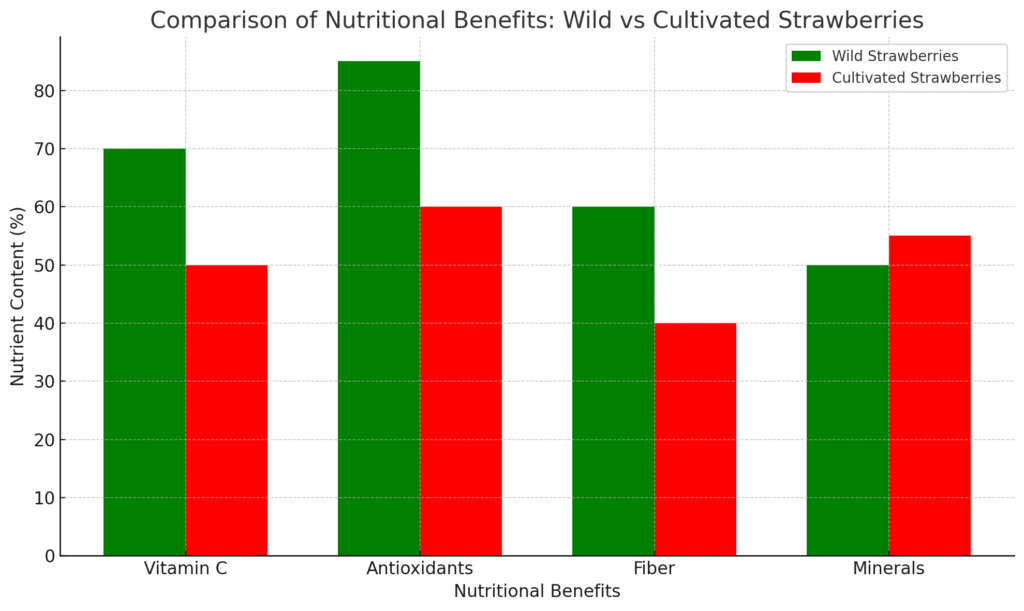
Recipe #2: Wild Strawberry and Spinach Salad
Inspired by the nutritional profile of wild strawberries, I created this salad that’s become a staple in my diet:
Ingredients:
- 2 cups fresh spinach
- 1 cup wild strawberries
- 1/4 cup chopped walnuts
- 2 tablespoons balsamic vinegar
- 1 tablespoon olive oil
- Salt and pepper to taste
Instructions:
- Wash and dry the spinach and strawberries, treating them gently.
- In a large bowl, combine the spinach, strawberries, and walnuts.
- In a small bowl, whisk together the balsamic vinegar and olive oil.
- Drizzle the dressing over the salad and toss gently.
- Season with salt and pepper to taste.
This salad is a symphony of flavors and textures. The sweetness of the strawberries balances perfectly with the earthy spinach and crunchy walnuts. The balsamic dressing adds a tangy note that ties everything together. Plus, I knew I was feeding my body a powerhouse of nutrients.
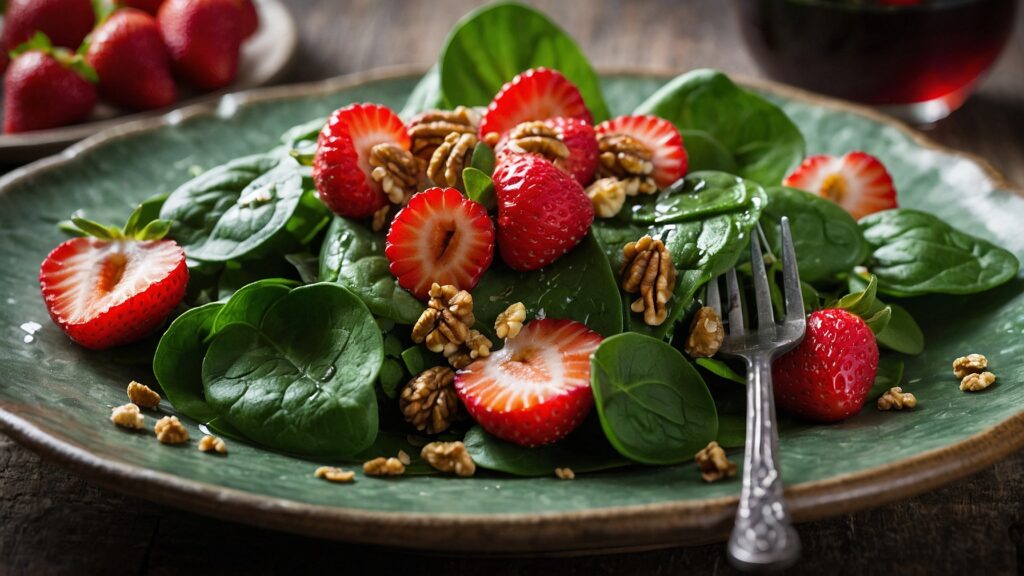
Cultural insight: Did you know that wild strawberries have been used in traditional medicine by many Indigenous cultures? The Iroquois, for example, used wild strawberry leaves to treat kidney and liver problems.
Overcoming Challenges: From Skeptic to Believer
Of course, my wild strawberry journey wasn’t without its challenges. Friends and family were skeptical at first. “Are you sure those are safe to eat?” they’d ask. Or, “Isn’t that just a weed?”
I understood their concerns. After all, foraging for wild foods can be intimidating if you don’t know what you’re doing. There were moments when I doubted myself too. What if I misidentified something? What if I was just going through a weird phase?
To address these concerns, I started inviting friends on my foraging trips. Seeing the plants in their natural habitat and learning how to identify them helped ease their worries. Plus, once they tasted the berries, most were converted!
Equip yourself for foraging adventures with this premium Nantucket Trader basket.
- Set of large and small home organizer baskets can hold snack , toy, skin-care products, book, socks to place on shelf, kitchen, bathroom vanity, TV bench, wardrobe and dresser
- The lid help to hide all clutter inside, make your home tidy and neat
- Add a natural elegance and warmth feel to your home
- Types and dimensions: small delicate type: 26*18*H15cm, large type: 31*22*19cm
- Multiple coats of varnish are applied to protect, strengthen and bring out the natural beauty of the materials, It will develop a rich dark patina over the years with use.Because it is cultivated weaving, the more it is used, the more flavor it has. It will turn into a shiny amber color through hand oil.
One friend, Sarah, was particularly skeptical. “I don’t eat anything I can’t buy in a store,” she declared. But after joining me on a foraging trip and tasting a wild strawberry for herself, she was amazed. “It’s like tasting what a strawberry is supposed to taste like for the first time,” she said, her eyes wide with surprise.
Reflection question: What’s something you were initially skeptical about, but changed your mind after trying? How did that experience change you?
Recipe #3: Wild Strawberry Leaf Tea
My wild strawberry obsession wasn’t limited to the fruit. I discovered that the leaves are also edible and make a delicious, healthy tea. This became my go-to afternoon drink, replacing my usual coffee habit.
Ingredients:
- 1 cup fresh wild strawberry leaves (or 1/4 cup dried)
- 4 cups boiling water
- Honey (optional)
Instructions:
- Rinse the fresh leaves (if using) and place them in a teapot.
- Pour boiling water over the leaves.
- Steep for 5-10 minutes.
- Strain and enjoy, adding honey if desired.
The tea has a subtle, pleasant flavor with grassy notes and a hint of sweetness. It’s caffeine-free, making it perfect for evening relaxation. I later learned it’s traditionally used to aid digestion and boost the immune system.
Preserve your wild harvest with this top-of-the-line Excalibur dehydrator.
- Large Capacity: Designed for heavy-duty use, this NSF-approved food dehydrator features a stainless steel interior and exterior and comes equipped with 10 Excalibur dehydrator trays that provide 16 square feet of drying space
- Versatile Uses: Features a 99-hour digital dehydrator timer and an adjustable thermostat with a range of 95 to 165 degrees F – low enough for fruits and vegetables but high enough for dehydrating meat
- Low & Slow for Immune Boost: Cooking foods at 115-118 degrees preserves nutrients and enzymes, making this the perfect dehydrator for food and jerky, dried fruit leather and fruit roll-ups, pet treats, yogurt, veggies, nuts, and even raising bread
- Faster & Easier to Use: This meat and fruit dehydrator features exclusive Excalibur Parallex Horizontal Airflow technology, which dehydrates food faster, retains more nutrients, and helps food look and taste better without requiring tray rotation
- Includes: Digital download of the Guide to Dehydration, 10 stainless steel trays, and a removable drip tray; Made in the USA with US- and globally sourced materials
Fun fact: In medieval times, wild strawberry leaves were often used as a symbol of purity and perfection in religious artwork.
The Ripple Effect: How Wild Strawberries Changed My Life
My wild strawberry adventure had effects far beyond my diet. Here are some unexpected ways it impacted my life:
- Increased outdoor time: I found myself spending more time in nature, always on the lookout for wild edibles. My skin developed a healthy glow from all the fresh air and sunshine.
- Better understanding of local ecosystems: I learned how wild strawberries interact with other plants and animals in their environment. It was like seeing the forest as a living, breathing entity for the first time.
- Reduced food waste: I became more appreciative of food in general, leading to less waste in my kitchen. Every berry, every leaf became precious.
- Community building: I started a local foraging group, connecting with like-minded individuals in my area. These connections blossomed into deep friendships built on shared values and experiences.
- Improved cooking skills: Experimenting with wild ingredients expanded my culinary repertoire. I found myself getting creative in the kitchen, inventing new recipes and combinations.
- Enhanced mindfulness: Foraging requires presence and attention to detail. This mindfulness practice spilled over into other areas of my life, helping me feel more grounded and centered.
- Boosted confidence: Successfully identifying and using wild plants gave me a sense of self-reliance I’d never experienced before. This newfound confidence affected everything from my work life to my personal relationships.
Small win celebration: I remember the first time I served a completely foraged meal to my family. The pride I felt in creating something delicious from ingredients I’d gathered myself was indescribable!
Sustainability and Ethics: Foraging Responsibly
As my passion for wild strawberries grew, so did my awareness of the importance of sustainable foraging practices. It’s crucial to approach foraging with respect for nature and an understanding of our impact on ecosystems.
Here are some guidelines I follow:
- Never take more than you need: Leave plenty for wildlife and plant regeneration.
- Avoid rare or endangered species: Stick to abundant plants like wild strawberries.
- Be mindful of your impact: Don’t trample other plants while foraging.
- Respect private property and protected areas: Always get permission before foraging.
- Learn and follow local regulations: Some areas have restrictions on foraging.
Remember, we’re guests in nature’s pantry. It’s our responsibility to ensure that these wild treasures are available for future generations to enjoy.
A Call to Action: Start Your Own Wild Food Journey
As I reflect on my wild strawberry journey, I’m amazed at how a simple question led to such a profound change in my life. If you’re intrigued by the idea of incorporating wild foods into your diet, here are some steps you can take:
- Learn from experts: Attend local foraging workshops or guided walks. There’s no substitute for hands-on learning!
- Start small: Begin with easily identifiable plants like wild strawberries. Build your confidence gradually.
- Always prioritize safety: Never eat anything you can’t identify with 100% certainty. When in doubt, leave it out!
- Respect nature: Only harvest what you need, leaving plenty for wildlife and plant regeneration.
- Share your experiences: Start a foraging journal or blog to document your journey. Connecting with others can enrich your experience.
- Experiment in the kitchen: Try incorporating wild foods into your favorite recipes. You might discover some amazing new flavors!
- Stay curious: There’s always more to learn about wild foods. Keep exploring, reading, and asking questions.
Interactive challenge: This week, try to identify three wild edible plants in your area (but don’t eat them yet!).
Start your wild food journey with this educational board game.
- FORAGING FUN FOR ALL - Gather the family and go on an imaginary adventure foraging plants through forests, trails, and waterfalls! Wildcraft!, one of our educational games for kids 8-12, introduces the wonderful world of herbs to kids as young as 4 years old.
- CULTIVATE HERB EDUCATION - Wildcraft cooperative board games for adults feature a wide selection of edible and medicinal herbs in attractive and child-friendly illustrations. Exciting way to start learning herb names, uses, and create building blocks for future knowledge.
- WITH EXTRA LEARNING TOOLS - Allow your kids to go deeper into wildcrafting with 3 printable PDFs included in our coop board games package. Wildcraft! learning games for kids 8-12 feed their curiosity about herbs with a Storybook, Pocket Plant Guide, and Coloring Book.
- COOPERATIVE BOARD GAME - Besides widening knowledge about plants and nature, Wildcraft! is one of our best board games for family night that encourages teamwork more than competition - family members work together on a mission to bring herbs to grammy's house!
- 100% FOR NATURE LOVERS - The Wildcraft! game is made with love for nature - composed of 100% recycled, recyclable, and non-toxic materials. Part of the proceeds go to United Plant Savers who protects native and medicinal plants in the USA and Canada.
The Transformative Power of Wild Foods
Remember, the world of wild edibles is vast and exciting, but it’s important to approach it with respect, caution, and a willingness to learn. Who knows? You might find yourself transformed, just like I was, by the humble wild strawberry.
So, the next time you’re out in nature and spot a patch of tiny red berries, ask yourself: “Are wild strawberries edible?” The answer might just lead you on your own incredible journey of discovery, one that could change your relationship with food, nature, and yourself.
As for me, my wild strawberry adventure continues. Each time I taste one of these tiny berries, I’m reminded of the day my curiosity led me down this path. It’s a journey that has nourished not just my body, but my soul. And isn’t that what food should do?
I invite you to take that first step, to look at the world around you with new eyes. You never know what magical discoveries await, perhaps right in your own backyard. Happy foraging!
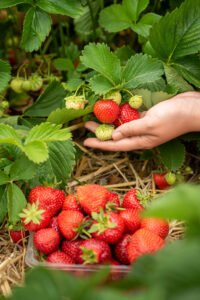
*We may earn a commission for purchases made using our links. Please see our disclosure to learn more.





